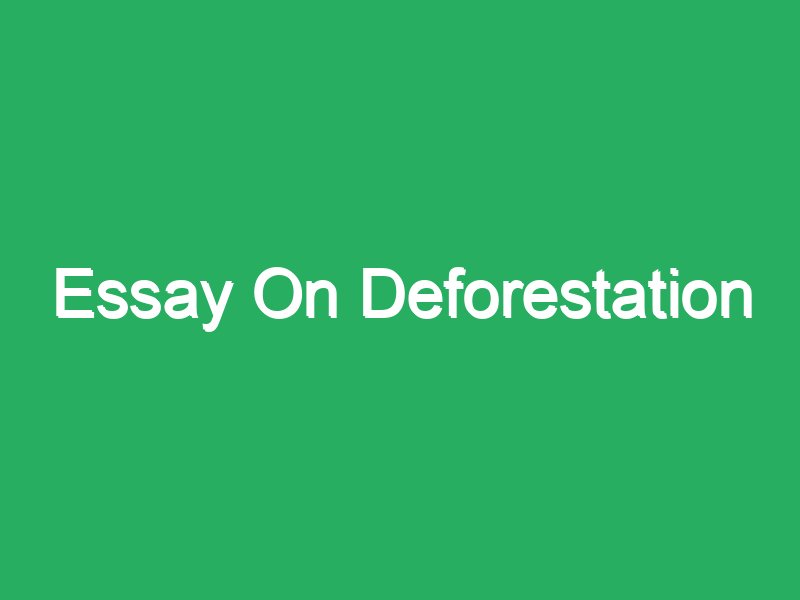Short Essay On Deforestation
Deforestation is the clearing of forests and the destruction of habitats and ecosystems for various reasons, including agriculture, urbanization, and the extraction of resources such as timber and minerals. It has far-reaching consequences for the environment, wildlife, and human communities, and is considered one of the leading drivers of climate change.
One of the most immediate impacts of deforestation is the loss of habitat and biodiversity. Forests are home to an estimated 80% of the world’s terrestrial biodiversity, and deforestation reduces the number of species and their habitats, leading to declines in population and sometimes extinction. In addition, forests play a critical role in regulating the Earth’s climate by absorbing and storing carbon dioxide, and deforestation releases this stored carbon back into the atmosphere, contributing to global warming.
Another impact of deforestation is soil erosion and degradation. Trees play an important role in maintaining soil stability and fertility, and without them, the soil can become degraded and less productive. This can have a negative impact on agricultural production and food security, particularly in developing countries where subsistence farming is a way of life.
Deforestation also has social and economic impacts, particularly for indigenous communities that depend on forests for their livelihoods. In many cases, deforestation results in the displacement of these communities, as well as the loss of traditional knowledge and cultural practices that are tied to the land. Moreover, deforestation can also contribute to conflict, as different groups compete for control over land and resources.
To address deforestation, a variety of strategies have been proposed and implemented, including the creation of protected areas, sustainable forest management, and the promotion of alternative livelihoods. Additionally, international agreements such as the Paris Agreement and the Convention on Biological Diversity have aimed to reduce deforestation and promote the conservation and sustainable use of forests.
In conclusion, deforestation is a complex and pressing global issue that has far-reaching impacts on the environment, wildlife, and human communities. Addressing deforestation requires a multi-faceted approach that involves the development of sustainable land use practices, the promotion of alternative livelihoods, and the protection of the rights of indigenous communities. By taking action to reduce deforestation, we can help to ensure the survival of our forests and the biodiversity they contain, and create a more sustainable future for all.
Long Essay On Deforestation
Deforestation is a major issue facing the environment, and has been for some time. Not only does it cause destruction of habitats for plants and animals, but it can also lead to global warming and climate change. In this essay, we will discuss in detail about deforestation, its causes, any potential solutions, and the impact it has on our planet.
Introduction: Definition and Overview of Deforestation
Deforestation is the removal of forests, by whatever means. It can refer to the natural loss of trees, as well as the potential destruction of forests due to the practices of people. Deforestation has many causes, including farming, ranching, logging, and mining. It often occurs in areas where there is a demand for land or resources, such as timber or minerals.
The impact of deforestation can be significant. It can lead to soil erosion, loss of biodiversity, and climate change. Deforestation also contributes to greenhouse gas emissions, which contribute to global warming.
Causes of Deforestation
Deforestation can be caused by a variety of factors, including agricultural expansion, logging, mining, and infrastructure development. Agricultural expansion is the leading cause of deforestation in the Amazon rainforest. Logging operations, both legal and illegal, also contribute to deforestation in the Amazon. Mining activities, particularly gold mining, are another major driver of deforestation in the region. Infrastructure development, such as road construction and dam building, can also lead to deforestation.
Effects of Deforestation
The loss of trees and other vegetation can cause climate change, desertification, soil erosion, fewer crops, flooding, increased greenhouse gases in the atmosphere, and a host of problems for indigenous people.
Solutions to Deforestation
-Deforestation is the conversion of a forested area to land that is not forested.
-Causes of Deforestation: Agriculture, Urbanization, Logging, Mining
-Effects of Deforestation: Climate Change, Soil Erosion, Flooding, biodiversity loss
-Solutions to Deforestation: Reforestation, afforestation, sustainable forestry practices
Conclusion
In conclusion, deforestation is an ongoing problem that needs to be addressed by the international community. It has caused significant environmental damage and threatens our way of life. We must work together to reduce deforestation and preserve our forests for future generations. There are a variety of solutions available, from using renewable energy sources to reforestation efforts, so there is something for everyone to do in order to help protect the environment. By working together we can make sure that our planet stays healthy and sustainable for many years to come.
Resources
Deforestation is the clear-cutting of trees in an area where forest once thrived. Deforestation can refer to the natural loss of trees, as well as the potential destruction of forests due to the practices of people. In many cases, deforestation is caused by a combination of both natural and man-made factors.
The consequences of deforestation are far-reaching and devastating. The loss of trees and other vegetation can cause climate change, desertification, soil erosion, fewer crops, flooding, increased greenhouse gases in the atmosphere, and a host of problems for indigenous people.
There are many ways to stop or slow down deforestation. One way is to promote sustainable forestry practices that protect forests and their ecosystems. Another way is to support companies and products that use sustainable sources for their wood and paper products. And finally, individuals can help by reducing their own consumption of wood and paper products.

Manisha Dubey Jha is a skilled educational content writer with 5 years of experience. Specializing in essays and paragraphs, she’s dedicated to crafting engaging and informative content that enriches learning experiences.
